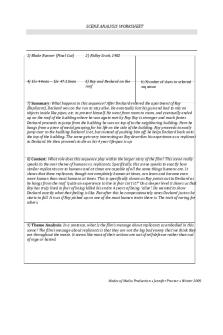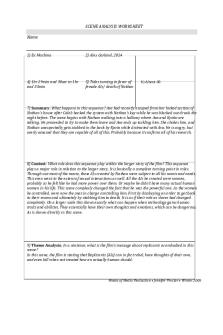Maleficent Scene Analysis PDF

| Title | Maleficent Scene Analysis |
|---|---|
| Course | Reading Film |
| Institution | Virginia Commonwealth University |
| Pages | 5 |
| File Size | 81.9 KB |
| File Type | |
| Total Downloads | 78 |
| Total Views | 375 |
Summary
Instructor: Longaker...
Description
Maleficent Scene Analysis In Robert Stromberg’s 2014 film, the classic fairy tale of Sleeping Beauty is retold. Maleficent puts a twist on what Disney previously established in 1959, and instead of being just an evil fairy that curses a princess for being scorned, she is now the protector of a magical forest realm known as the Moors and suffers betrayal at the hands of humans (“Maleficent”). Due to being a victim of metaphorical rape, Maleficent turns towards darkness. Despite being exploited by Stefan in his successful attempt for the throne, she overcomes her vulnerabilities and is redeemed in the end. Through the cinematography of this film, Maleficent’s strength – both emotional and physical – are highlighted, particularly in the battle against King Henry and his army, therefore showing from the very beginning that she is meant to be seen as the superior being and would come out victorious in the end. The scene chosen takes place before Stefan severs Maleficent’s wings. Henry, the king of a neighboring human kingdom, attempts to conquer the Moors for its riches and natural resources. However, Maleficent fulfills her role as guardian and defends her home alongside her fellow magical warriors. As a result, King Henry is mortally wounded and the humans are eventually forced to retreat. Throughout the entire film, color is utilized as a way to reflect Maleficent’s outlook, and the battle scene is no exception. The scene marks the beginning of a lack of saturation in the film. The warmness seen initially is replaced with cool blues and grey hues. This shift signifies a change in the overall tone of the film, as Maleficent is slowly realizing that a majority of the humans are fueled by nothing but greed (Shapiro). The color change can also be viewed from the humans’ perspective, representing the escalation of their distrust and fear towards the creatures of the Moors. In this scene, Maleficent is seen wearing a brown gown adorned with leather
accessories and feather shoulder-pieces. Like the rest of her clothes, this outfit incorporates many elements from nature, specifically natural colors in this case. The brown of her dress helps viewers connect Maleficent with the Moors. She is more in touch with nature and stands for the protection of its environment, contrasting King Henry and his army who are clothed in manufactured red and yellow. Red can be interpreted as dangerous because of its association with blood, emphasizing the humans’ desire for even more power (“How Filmmakers Use Color”). Yellow portrays the volatile behavior exhibited by King Henry which foreshadows the insanity Stefan succumbs to, leading to his eventual demise. The contrast between madness and violence versus being grounded is one of many factors that illustrate Maleficent’s strength. She has the will to overcome grief and anger whereas the humans gradually give into it. Lighting plays a crucial role in this film, as it visually highlights Maleficent’s journey from good to evil and then ultimately back to good. Up until she turns evil, there is a key light that follows her, which can be observed in the battle (Tharpe). Towards the beginning of the scene, there is an establishing shot that shows the edge of the Moors, indicating to viewers that King Henry and his army have reached the border. In this shot, sunlight peeks out from behind the clouds and diffracts around the stones dividing the human and magic realms. Because the light is directly shining onto the Moors, it is reminiscent and symbolic of Heaven or El Dorado. The Moors are seen as a “Holy Grail” to the humans. It is a place containing treasures that they demand access to, but only those that are deserving and have earned the trust of the inhabitants can enter. The same beams of light also surround Maleficent when she flies into the battlefield, creating a halo-like effect and demonstrates how she could be depictive of a godlike figure. Given her duty to protect the Moors, the light elevates her status to something akin to a savior, predicting how she will be the one to save Aurora and the Moors. The lighting essentially
glorifies Maleficent and thus exemplifies how she will triumph over the humans against her in the end. One of the most significant and easily identifiable ways the battle scene indicates that Maleficent will be the hero of the story is through the film’s utilization of different angles and the placement of Maleficent herself in various shots. In almost every shot of King Henry in this scene, he is flanked by his soldiers or shown in front of them. Meanwhile, most shots of Maleficent show her alone. This choice is extremely clever and emphasizes how Maleficent is capable of asserting dominance in this situation. She is strong enough to stand alone and defend the Moors while King Henry requires the force of his soldiers to even remotely level the playing field. The battle scene also exhibits several close-up shots of Maleficent. These shots accentuate her subtlest expressions to the viewers, subsequently connecting the viewers to her because they are now both emotionally and physically closer (Sikov 10). Since Maleficent is closer and takes up a majority of the screen, her actions now carry more emotional weight. Additionally, there are several prominent low-angle shots of her featured in this scene. The viewers are looking up to her not only because she is standing on a rock when she lands in the battlefield, but due to the upper hand she has in the war the humans will wage on her. This angle establishes who holds the power by aggrandizing the subject of the shot (13). The idea that Maleficent is the clear superior being when contrasted to the humans is further supported when she takes flight and aerial shots are shown of the battle. This angle displays how she is figuratively above the humans because she does not stoop to their level of materialism. She is emotionally strong enough to resist greed and for that reason, Maleficent stands as victor against the humans. Through the color theory, lighting, and camera work, this film is able to communicate viewers what Maleficent is capable of and how she would prevail over her adversities. Both her
emotional and physical strength are presented in a multitude of ways, and due to this strength is she able to reclaim redemption. This film tells the story of not only Sleeping Beauty, but also of a woman who suffers the repercussions of ambition driven by the materialistic nature of those that seek to use her, and only through strength and stability can this be overcome.
Works Cited “How Filmmakers Use Colors To Set The Mood Of A Film.” Digital Synopsis, Digital Synopsis, digitalsynopsis.com/design/film-movies-color-psychology/. “Maleficent.” IMDb, IMDb.com, Inc., 28 May 2014, www.imdb.com/title/tt1587310/. Shapiro, Jordan. “Why Disney's 'Maleficent' Matters.” Forbes, Forbes Media LLC, 5 June 2014, www.forbes.com/sites/jordanshapiro/2014/06/05/why-disneys-maleficentmatters/#42a248b03901. Sikov, Ed. Film Studies: An Introduction. Columbia University Press, 2020. Tharpe, Taylor. “'Maleficent' Movie Review On Film Technique.” The Odyssey Online, Odyssey, 8 Aug. 2016, www.theodysseyonline.com/maleficent-movie-review....
Similar Free PDFs

Maleficent Scene Analysis
- 5 Pages

Ex-Machina Scene Analysis
- 3 Pages

Scene Analysis Worksheet
- 4 Pages

Paper 1 - Scene Analysis
- 4 Pages

Jaws Scene Analysis
- 3 Pages

Scene Analysis - Grade: A
- 6 Pages

Blade Runner Scene Analysis
- 3 Pages

Maleficent and sleeping beauty
- 2 Pages

Film Scene Analysis The Insider
- 1 Pages

Maleficent 1 - Grade: A
- 5 Pages
Popular Institutions
- Tinajero National High School - Annex
- Politeknik Caltex Riau
- Yokohama City University
- SGT University
- University of Al-Qadisiyah
- Divine Word College of Vigan
- Techniek College Rotterdam
- Universidade de Santiago
- Universiti Teknologi MARA Cawangan Johor Kampus Pasir Gudang
- Poltekkes Kemenkes Yogyakarta
- Baguio City National High School
- Colegio san marcos
- preparatoria uno
- Centro de Bachillerato Tecnológico Industrial y de Servicios No. 107
- Dalian Maritime University
- Quang Trung Secondary School
- Colegio Tecnológico en Informática
- Corporación Regional de Educación Superior
- Grupo CEDVA
- Dar Al Uloom University
- Centro de Estudios Preuniversitarios de la Universidad Nacional de Ingeniería
- 上智大学
- Aakash International School, Nuna Majara
- San Felipe Neri Catholic School
- Kang Chiao International School - New Taipei City
- Misamis Occidental National High School
- Institución Educativa Escuela Normal Juan Ladrilleros
- Kolehiyo ng Pantukan
- Batanes State College
- Instituto Continental
- Sekolah Menengah Kejuruan Kesehatan Kaltara (Tarakan)
- Colegio de La Inmaculada Concepcion - Cebu





